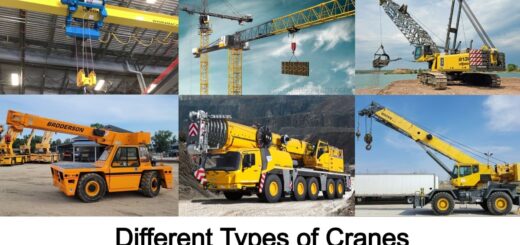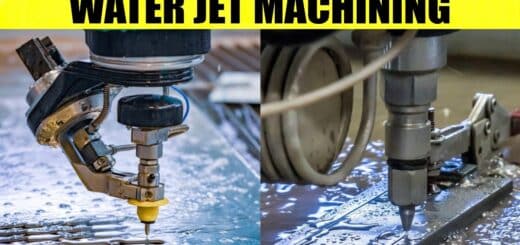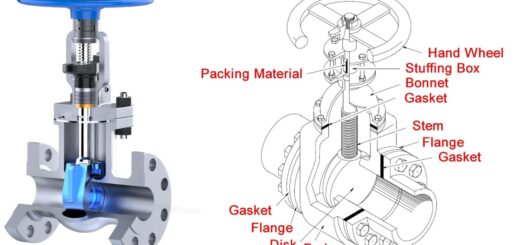Types of Belt Drive: Material, Applications, Advantages & Disadvantages

What is Belt Drives?
Types of Belt Drive: Material, Applications, Advantages & Disadvantages :- A belt drive is referred to as that mechanism wherein the power gets transmitted by the movement of a continuous flexible belt. This is used in order to transmit the rotational motion from one mechanical element to another. A belt is referred to as a looped strip of flexible material which is used to mechanically link either two or more rotating shafts. A belt drive is found in almost every possible modern engine available in the market.
Types of Belt Drives
There are five different types of belt drive which are commonly known to mankind which are mentioned below:
- Open belt drive
- Closed or crossed belt drive
- Fast and loose cone pulley
- Stepped cone pulley
- Jockey pulley drive
1. Open Belt Drive: ( Types of Belt Drive )
Open belt drive is referred to as that drive which comprises of the shafts rotation in the similar direction which means that the direction of rotation is found to be same as the driving and the driven pulley.
The shafts seem to be arranged in the parallel directions. In case the shafts are found having more distance within the driver and the driving pulley then there must be the upper side, which can be the slack side and the below side, the tight side.
2. Crossed Belt Drive: ( Types of Belt Drive )
Crossed belt drive also known to be closed belt drive and is referred to as that drive which has transmitted more power but there is a problem that it cannot run that faster. This is the reason which creates rubbing between belts and leads to wear and tear.
In this type of belt drive, the shafts are found to rotate in the opposite direction. At the junction side, it is found to rub and therefore it wears and tears off. If you wish to keep your belt away from wear and tear then you must place more distance within the pulley and also run it at lower speed.
3. Fast and Loose Cone Pulley: ( Types of Belt Drive )
As the name indicates that fast and loose pulley means that there are two pulleys inside it. But it needs to be understood how these two pulleys are placed inside each other.
The fast pulley is found to be mounted on a shaft accompanied with a key joint and the loose pulley is found to run freely on the shaft due to which it is incapable of transmitting any power. Another term in that is when the multiple machines are found working from a single power source then in this type of condition, each machine has provided with this fast and loose cone pulley.
4. Stepped Cone Pulley Drive: ( Types of Belt Drive )
Stepped cone pulley is also referred to as speed cone. There are more pulleys which are attached to the different diameter wherein one is attached adjacent to another.
Stepped cone pulleys are used where there is a need to change gear or speed of driven shaft, or change frequently like in the case of a machine lathe, milling etc.
The diameter of the driving and driven pulley is such that whenever one wishes to shift to another pulley the same belt can operate.
5. Jockey Pulley Drive: ( Types of Belt Drive )
Jockey pulleys are referred to as those pulleys which are used in the steering section of any system. Jockey pulley is termed to be an idle pulley which is found to be used in increasing the angle of contact in an open belt drive. By increasing the angle of the contact steer, the power of the transmission capacity of the drive gets increased.
This one pulley is found to be mounted nearer to the smaller pulley wherein we can say that this is placed on the slack side of the belt. It is found to help in increasing the angle of contact of the belt, so that the belt tension can be increased and also the drive is found providing a high-velocity ratio.
Applications of Belt Drive
There are various applications of a belt-drives which are used in various places like:
- A belt drive is used for transferring the power.
- The belt drive is used in the Mill industry.
- The belt drive is used in the Conveyor.
- The belt drive is powered by only a single belt.
- Belt drives are usually made up of synthetic material.
- This is not stronger as compared to the belt drive.
- Belt drives are used in mills.
- Difficult to repair if damaged.
- Low or medium in price
- The belt drive does not require lubricating system
- The belt drive is quieter as compared to the chain drive.
Different Types of Belt
The belts are found to be categorized into four different types which are stated below:
● Flat belt
● V belt and
● Circular belt
● Timing belt
1. Flat Belt Drive
A flat belt is referred to as a kind of rectangular cross-section which is used at the places that require low power and more speed. Generally, the distance of the shaft is found to be within 5 to 10 meters.
Flat belt transmits power by the help of friction which gets produced within the belt and the pulley. The rotation of the pulley is found to be in the same direction in the flat belt. The flat belt is found to have an efficiency of around 98 percent, which results in very little noise in this belt.
2. V Belt Drive
V belts are referred to as those kinds of belts which are found to be in the trapezoidal cross-section. These belts are mostly used whenever the distance of the shaft is considered less than 2 meters and is also used for a moderate speed and high power.
In these types of belt there is a possibility of multiple drives.
3. Circular Belt Drive
Circular belt is referred to as that in which there is a circular cross-section. These are the belts which are used at places where there is more than 5-meter shaft distance.
Circular belts are used mostly for high transmission of power and are also used at places where there is smaller initial tension required and absence of vibration and noise is present.
4. Timing Belt Drive
Timing belt is referred to as an alternate type of belt which is mainly used inside in the system to transmit power. Timing belts are mostly found to have a positive drive and is a precise and reliable type of belt.
Materials Used in Belt Drive
For selecting the belt type of material, you should follow some of the below mentioned properties which will help you in buying an ideal belt:
- The belt should be flexible
- It should be reliable and durable.
- The material should be capable of withstanding high tensile stress.
- Higher temperature should be resisted.
- The weight per unit length should be less.
- Higher coefficient of friction within the belt and pulley.
- It should have an excellent resistance to wear and fatigue.
It is important to know that there are 5 different types of material which are used for making the belts:
- Leather belt
- Rubber belt
- Cotton or Fabric belt
- Plastic belt
- Balata belt
1. Leather Belt
Leather belts are referred to as one of the most important type of belt which was first found in Egypt. These belts are commonly found in day to day life.
Leather belts are found to be more expensive as compared to the other belts which are made of cloth or any recycled materials. In order to make leather belt strong, one layer of the leather is joint to another layer in order to make it stronger and to also increase the thickness of the belt.
2. Rubber Belt
A rubber belt is referred to as that belt which is made up of fabric and is commonly used in sawmills, paper mills etc.
3. Cotton or Fabric Belt
Cotton or fabric belt is referred to as that type which is mostly used in the farm machinery and belt conveyor. This type of belt is cheaper and also best suited for warm climates and a damp atmosphere.
4. Plastic Belt
Plastic belts are the ones which are made up of plastic sheets and rubber layers. The main advantage of a plastic belt is that it can be designed in almost any size which depends on the site requirement.
5. Balata Belt
Balata belts are referred to as those belts which seem similar to the rubber type belts but are found to be stronger than them. The balata gum is used here to stick the belt properly.
This type of belt is found to be waterproof and has a high resistance to acidic, alkaline material so this is mostly used for food packaging conveyor. This is not meant for high temperatures as the balata becomes sticky gum at a higher temperature.
Selection of Belt-Drive
The selection of belt drive depends on various factors. Some of them are listed here, for you to select the best belt drive:
- It should have a positive drive.
- The Centre distance within the shaft and pulley should be proper.
- The speed of the driver and driven pulley should be tested and considered.
- Power transmission system of the drive should be considered.
- The layout of shafts should also be considered.
Advantages of Belt Drive
By now, you all must be aware about the types of belt drive, along with materials. So now, here we aim to discuss the advantages of a belt-drive which are mentioned below:
- It can be easily installed and removed.
- The price of the belt drive is not too high.
- Simple in construction.
- Low maintenance cost.
- No additional lubrication is needed.
- Capable of transferring power vertically, horizontally and in inclined plane too.
- Power consumption is quite low.
Disadvantages of Belt Drive
Knowing just the advantages is not important, therefore here are some disadvantages of the belt drives which are mentioned below:
- Loss of power due to slip and creep.
- Cannot be used for a very short distance.
- Speed is limited to an extent.
- Works very silently.
- No possibility of longer life.
- Chances of breaking are very frequent.
- The operation temperature is just limited within -35 to 85 degrees Celsius. As soon as it exceeds the temperature then it can cause extreme wear and tear.
- The angular velocity ratio is not necessarily constant or equal to the ratio of pulley’s diameter due to the slipping.
Chain Drive
- The chain drive is also used for transferring the power.
- Chain drives are usually made up of metal which is stronger and more durable.
- The chain drive is used in bicycles, motorcycles etc.
- The chain drive is found to be powered via a chain loop.
- It is easier to either change or fix it whenever it gets damaged
- The chain drive needs a lubricating system
- The chain drive is not silent as compared to a belt drive.
Slip in Belt Drive
It is important to have a firm frictional grip within the belt and shaft but at times it becomes insufficient. This can result in some motion in the forward direction of the belt without carrying the driven pulley with it. This is referred to as a slip of the belt which is usually expressed in percentage.
Creep in Belt Drive
Whenever it is found that the belt passes from the slack side to tight side, a certain portion of the belt is found to extend and when the belt passes from tight sight to slack side it gets contacted. Due to these changes in the length, there is a relative motion within the belt and the pulley surfaces. This relative motion is referred to as creep.
Difference Between Slip and Creep in Belt Drive
Creep is referred to as a phenomenon which is caused due to the elastic property of the belt whereas, the conventional slip happens due to insufficient frictional grip within the belt and the pulley. Whereas, the effect of creep and slip, is found to reduce the ratio of the speed along with the power transmission.
Image Source :- tec-science, beltdrives, mechanical-engg, habasit













